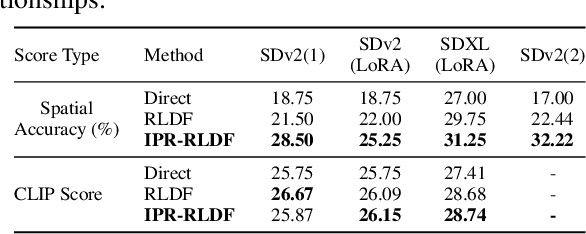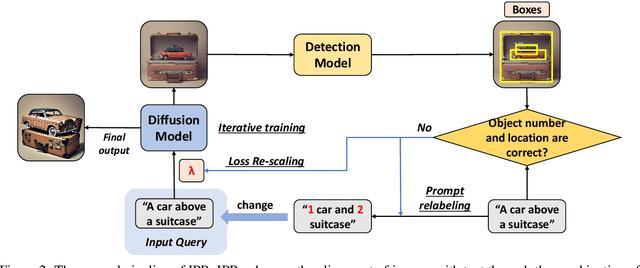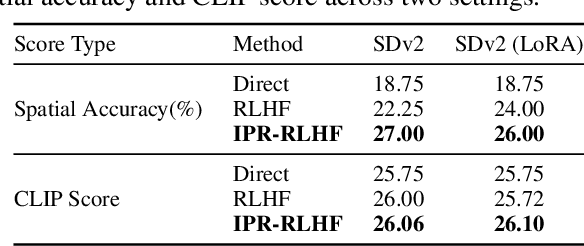Xinyan Chen
Zero-Shot Open-Vocabulary Human Motion Grounding with Test-Time Training
Nov 19, 2025Abstract:Understanding complex human activities demands the ability to decompose motion into fine-grained, semantic-aligned sub-actions. This motion grounding process is crucial for behavior analysis, embodied AI and virtual reality. Yet, most existing methods rely on dense supervision with predefined action classes, which are infeasible in open-vocabulary, real-world settings. In this paper, we propose ZOMG, a zero-shot, open-vocabulary framework that segments motion sequences into semantically meaningful sub-actions without requiring any annotations or fine-tuning. Technically, ZOMG integrates (1) language semantic partition, which leverages large language models to decompose instructions into ordered sub-action units, and (2) soft masking optimization, which learns instance-specific temporal masks to focus on frames critical to sub-actions, while maintaining intra-segment continuity and enforcing inter-segment separation, all without altering the pretrained encoder. Experiments on three motion-language datasets demonstrate state-of-the-art effectiveness and efficiency of motion grounding performance, outperforming prior methods by +8.7\% mAP on HumanML3D benchmark. Meanwhile, significant improvements also exist in downstream retrieval, establishing a new paradigm for annotation-free motion understanding.
Are Video Models Ready as Zero-Shot Reasoners? An Empirical Study with the MME-CoF Benchmark
Oct 30, 2025Abstract:Recent video generation models can produce high-fidelity, temporally coherent videos, indicating that they may encode substantial world knowledge. Beyond realistic synthesis, they also exhibit emerging behaviors indicative of visual perception, modeling, and manipulation. Yet, an important question still remains: Are video models ready to serve as zero-shot reasoners in challenging visual reasoning scenarios? In this work, we conduct an empirical study to comprehensively investigate this question, focusing on the leading and popular Veo-3. We evaluate its reasoning behavior across 12 dimensions, including spatial, geometric, physical, temporal, and embodied logic, systematically characterizing both its strengths and failure modes. To standardize this study, we curate the evaluation data into MME-CoF, a compact benchmark that enables in-depth and thorough assessment of Chain-of-Frame (CoF) reasoning. Our findings reveal that while current video models demonstrate promising reasoning patterns on short-horizon spatial coherence, fine-grained grounding, and locally consistent dynamics, they remain limited in long-horizon causal reasoning, strict geometric constraints, and abstract logic. Overall, they are not yet reliable as standalone zero-shot reasoners, but exhibit encouraging signs as complementary visual engines alongside dedicated reasoning models. Project page: https://video-cof.github.io
MINT-CoT: Enabling Interleaved Visual Tokens in Mathematical Chain-of-Thought Reasoning
Jun 05, 2025Abstract:Chain-of-Thought (CoT) has widely enhanced mathematical reasoning in Large Language Models (LLMs), but it still remains challenging for extending it to multimodal domains. Existing works either adopt a similar textual reasoning for image input, or seek to interleave visual signals into mathematical CoT. However, they face three key limitations for math problem-solving: reliance on coarse-grained box-shaped image regions, limited perception of vision encoders on math content, and dependence on external capabilities for visual modification. In this paper, we propose MINT-CoT, introducing Mathematical INterleaved Tokens for Chain-of-Thought visual reasoning. MINT-CoT adaptively interleaves relevant visual tokens into textual reasoning steps via an Interleave Token, which dynamically selects visual regions of any shapes within math figures. To empower this capability, we construct the MINT-CoT dataset, containing 54K mathematical problems aligning each reasoning step with visual regions at the token level, accompanied by a rigorous data generation pipeline. We further present a three-stage MINT-CoT training strategy, progressively combining text-only CoT SFT, interleaved CoT SFT, and interleaved CoT RL, which derives our MINT-CoT-7B model. Extensive experiments demonstrate the effectiveness of our method for effective visual interleaved reasoning in mathematical domains, where MINT-CoT-7B outperforms the baseline model by +34.08% on MathVista, +28.78% on GeoQA, and +23.2% on MMStar, respectively. Our code and data are available at https://github.com/xinyan-cxy/MINT-CoT
EmpathyAgent: Can Embodied Agents Conduct Empathetic Actions?
Mar 19, 2025Abstract:Empathy is fundamental to human interactions, yet it remains unclear whether embodied agents can provide human-like empathetic support. Existing works have studied agents' tasks solving and social interactions abilities, but whether agents can understand empathetic needs and conduct empathetic behaviors remains overlooked. To address this, we introduce EmpathyAgent, the first benchmark to evaluate and enhance agents' empathetic actions across diverse scenarios. EmpathyAgent contains 10,000 multimodal samples with corresponding empathetic task plans and three different challenges. To systematically evaluate the agents' empathetic actions, we propose an empathy-specific evaluation suite that evaluates the agents' empathy process. We benchmark current models and found that exhibiting empathetic actions remains a significant challenge. Meanwhile, we train Llama3-8B using EmpathyAgent and find it can potentially enhance empathetic behavior. By establishing a standard benchmark for evaluating empathetic actions, we hope to advance research in empathetic embodied agents. Our code and data are publicly available at https://github.com/xinyan-cxy/EmpathyAgent.
MME-CoT: Benchmarking Chain-of-Thought in Large Multimodal Models for Reasoning Quality, Robustness, and Efficiency
Feb 13, 2025



Abstract:Answering questions with Chain-of-Thought (CoT) has significantly enhanced the reasoning capabilities of Large Language Models (LLMs), yet its impact on Large Multimodal Models (LMMs) still lacks a systematic assessment and in-depth investigation. In this paper, we introduce MME-CoT, a specialized benchmark evaluating the CoT reasoning performance of LMMs, spanning six domains: math, science, OCR, logic, space-time, and general scenes. As the first comprehensive study in this area, we propose a thorough evaluation suite incorporating three novel metrics that assess the reasoning quality, robustness, and efficiency at a fine-grained level. Leveraging curated high-quality data and a unique evaluation strategy, we conduct an in-depth analysis of state-of-the-art LMMs, uncovering several key insights: 1) Models with reflection mechanism demonstrate a superior CoT quality, with Kimi k1.5 outperforming GPT-4o and demonstrating the highest quality results; 2) CoT prompting often degrades LMM performance on perception-heavy tasks, suggesting a potentially harmful overthinking behavior; and 3) Although the CoT quality is high, LMMs with reflection exhibit significant inefficiency in both normal response and self-correction phases. We hope MME-CoT serves as a foundation for advancing multimodal reasoning in LMMs. Project Page: https://mmecot.github.io/
X-Fi: A Modality-Invariant Foundation Model for Multimodal Human Sensing
Oct 14, 2024Abstract:Human sensing, which employs various sensors and advanced deep learning technologies to accurately capture and interpret human body information, has significantly impacted fields like public security and robotics. However, current human sensing primarily depends on modalities such as cameras and LiDAR, each of which has its own strengths and limitations. Furthermore, existing multi-modal fusion solutions are typically designed for fixed modality combinations, requiring extensive retraining when modalities are added or removed for diverse scenarios. In this paper, we propose a modality-invariant foundation model for all modalities, X-Fi, to address this issue. X-Fi enables the independent or combinatory use of sensor modalities without additional training by utilizing a transformer structure to accommodate variable input sizes and incorporating a novel "X-fusion" mechanism to preserve modality-specific features during multimodal integration. This approach not only enhances adaptability but also facilitates the learning of complementary features across modalities. Extensive experiments conducted on the MM-Fi and XRF55 datasets, employing six distinct modalities, demonstrate that X-Fi achieves state-of-the-art performance in human pose estimation (HPE) and human activity recognition (HAR) tasks. The findings indicate that our proposed model can efficiently support a wide range of human sensing applications, ultimately contributing to the evolution of scalable, multimodal sensing technologies.
PsyDI: Towards a Personalized and Progressively In-depth Chatbot for Psychological Measurements
Jul 22, 2024Abstract:In the field of psychology, the static nature and lack of customization of psychological test scales, along with the challenge of quantifying psychological indicators, have long been critical issues. Despite numerous attempts to use AI to address psychological challenges, a dynamically interactive psychological test has yet to emerge. In contrast to traditional psychological assessment methods, we propose PsyDI, a multi-modal, interactive, and customized chatbot for psychological assessments, using the Myers-Briggs Type Indicator (MBTI) as an example. PsyDI initiates with user-related multi-modal information, then engaging in customized interaction to discern the user's MBTI type based on their multiple rounds of responses. Despite these advancements, accurately quantifying absolute value of psychological indicators remains challenging. To tackle such difficulty, we introduce the PsyDI framework that trains LLMs to discern the relative magnitude of psychological traits rather than their absolute values. Through various experiments, we demonstrate the effectiveness of the training techniques proposed in PsyDI on various datasets, and we have also launched its web version, reaching about ~3k accesses. Additionally, comprehensive post-deployment data analysis has provided profound insights into the implications and applications of PsyDI, demonstrating its potential to serve as a general framework for psychological assessment.
Iterative Prompt Relabeling for diffusion model with RLDF
Dec 23, 2023



Abstract:Diffusion models have shown impressive performance in many domains, including image generation, time series prediction, and reinforcement learning. The algorithm demonstrates superior performance over the traditional GAN and transformer based methods. However, the model's capability to follow natural language instructions (e.g., spatial relationships between objects, generating complex scenes) is still unsatisfactory. This has been an important research area to enhance such capability. Prior works adopt reinforcement learning to adjust the behavior of the diffusion models. However, RL methods not only require careful reward design and complex hyperparameter tuning, but also fails to incorporate rich natural language feedback. In this work, we propose iterative prompt relabeling (IP-RLDF), a novel algorithm that aligns images to text through iterative image sampling and prompt relabeling. IP-RLDF first samples a batch of images conditioned on the text, then relabels the text prompts of unmatched text-image pairs with classifier feedback. We conduct thorough experiments on three different models, including SDv2, GLIGEN, and SDXL, testing their capability to generate images following instructions. With IP-RLDF, we improved up to 15.22% (absolute improvement) on the challenging spatial relation VISOR benchmark, demonstrating superior performance compared to previous RL methods.
MM-Fi: Multi-Modal Non-Intrusive 4D Human Dataset for Versatile Wireless Sensing
May 12, 2023Abstract:4D human perception plays an essential role in a myriad of applications, such as home automation and metaverse avatar simulation. However, existing solutions which mainly rely on cameras and wearable devices are either privacy intrusive or inconvenient to use. To address these issues, wireless sensing has emerged as a promising alternative, leveraging LiDAR, mmWave radar, and WiFi signals for device-free human sensing. In this paper, we propose MM-Fi, the first multi-modal non-intrusive 4D human dataset with 27 daily or rehabilitation action categories, to bridge the gap between wireless sensing and high-level human perception tasks. MM-Fi consists of over 320k synchronized frames of five modalities from 40 human subjects. Various annotations are provided to support potential sensing tasks, e.g., human pose estimation and action recognition. Extensive experiments have been conducted to compare the sensing capacity of each or several modalities in terms of multiple tasks. We envision that MM-Fi can contribute to wireless sensing research with respect to action recognition, human pose estimation, multi-modal learning, cross-modal supervision, and interdisciplinary healthcare research.
HardSATGEN: Understanding the Difficulty of Hard SAT Formula Generation and A Strong Structure-Hardness-Aware Baseline
Feb 11, 2023Abstract:Industrial SAT formula generation is a critical yet challenging task for heuristic development and the surging learning-based methods in practical SAT applications. Existing SAT generation approaches can hardly simultaneously capture the global structural properties and maintain plausible computational hardness, which can be hazardous for the various downstream engagements. To this end, we first present an in-depth analysis for the limitation of previous learning methods in reproducing the computational hardness of original instances, which may stem from the inherent homogeneity in their adopted split-merge procedure. On top of the observations that industrial formulae exhibit clear community structure and oversplit substructures lead to the difficulty in semantic formation of logical structures, we propose HardSATGEN, which introduces a fine-grained control mechanism to the neural split-merge paradigm for SAT formula generation to better recover the structural and computational properties of the industrial benchmarks. Experimental results including evaluations on private corporate data and hyperparameter tuning over solvers in practical use show the significant superiority of HardSATGEN being the only method to successfully augments formulae maintaining similar computational hardness and capturing the global structural properties simultaneously. Compared to the best previous methods to our best knowledge, the average performance gains achieve 38.5% in structural statistics, 88.4% in computational metrics, and over 140.7% in the effectiveness of guiding solver development tuned by our generated instances.
 Add to Chrome
Add to Chrome Add to Firefox
Add to Firefox Add to Edge
Add to Edge